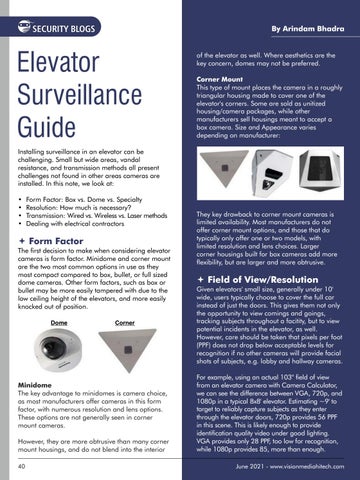By Arindam Bhadra
Elevator Surveillance Guide
of the elevator as well. Where aesthetics are the key concern, domes may not be preferred. Corner Mount This type of mount places the camera in a roughly triangular housing made to cover one of the elevator's corners. Some are sold as unitized housing/camera packages, while other manufacturers sell housings meant to accept a box camera. Size and Appearance varies depending on manufacturer:
Installing surveillance in an elevator can be challenging. Small but wide areas, vandal resistance, and transmission methods all present challenges not found in other areas cameras are installed. In this note, we look at: • • • •
Form Factor: Box vs. Dome vs. Specialty Resolution: How much is necessary? Transmission: Wired vs. Wireless vs. Laser methods Dealing with electrical contractors
Form Factor The first decision to make when considering elevator cameras is form factor. Minidome and corner mount are the two most common options in use as they most compact compared to box, bullet, or full sized dome cameras. Other form factors, such as box or bullet may be more easily tampered with due to the low ceiling height of the elevators, and more easily knocked out of position. Dome
Corner
Minidome The key advantage to minidomes is camera choice, as most manufacturers offer cameras in this form factor, with numerous resolution and lens options. These options are not generally seen in corner mount cameras. However, they are more obtrusive than many corner mount housings, and do not blend into the interior 40
They key drawback to corner mount cameras is limited availability. Most manufacturers do not offer corner mount options, and those that do typically only offer one or two models, with limited resolution and lens choices. Larger corner housings built for box cameras add more flexibility, but are larger and more obtrusive.
Field of View/Resolution Given elevators' small size, generally under 10' wide, users typically choose to cover the full car instead of just the doors. This gives them not only the opportunity to view comings and goings, tracking subjects throughout a facitity, but to view potential incidents in the elevator, as well. However, care should be taken that pixels per foot (PPF) does not drop below acceptable levels for recognition if no other cameras will provide facial shots of subjects, e.g. lobby and hallway cameras. For example, using an actual 103° field of view from an elevator camera with Camera Calculator, we can see the difference between VGA, 720p, and 1080p in a typical 8x8' elevator. Estimating ~9' to target to reliably capture subjects as they enter through the elevator doors, 720p provides 56 PPF in this scene. This is likely enough to provide identification quality video under good lighting. VGA provides only 28 PPF, too low for recognition, while 1080p provides 85, more than enough. June 2021 - www.visionmediahitech.com










